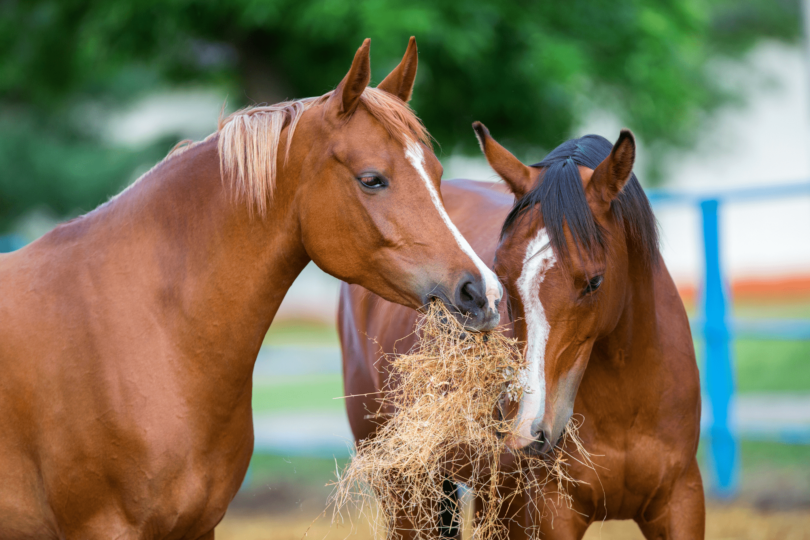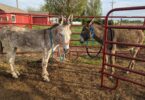The cost of horse ownership starts with the cost of food
If you’ve spent any length of time around horses, you know they absolutely love food and love eating. They spend most of their time on pasture – munching away for a whopping 16 to 20 hours a day.
And if they’re stalled, they’ll always be ready for a bite to eat. Near-constant consumption of forage is essential to keeping a horse’s digestive system healthy so there can be quite the sticker shock when you first dive into equine ownership.
The cost to feed a horse can vary pretty wildly based on the individual horse and where you live. Forage, which is vital to a horse’s health, can range from $4 a bale to over $19 a bale. With so many factors it can be a struggle to generalize how much a person can expect to pay. A horse that costs $730 a year to feed in one place can cost almost $3,000 a year in another place.
So how do you figure out what it’ll cost you?
Average Monthly Cost to Feed a Horse
Hay
Hay is one of the most important parts of your horse’s diet. It can be tempting to feed more grain in an effort to use less hay, but a horse really needs all that long-stem forage to stay healthy and happy. There are many different species of grass and legume on the market, and they all have their own pros and cons.
The cost of hay depends entirely on where you live and who you buy from. In areas where hay is commonly grown you can spend as little as $5 per bale, but if you travel to areas where hay needs to be trucked in you could easily spend $19 for the same bale. Certain types of hay also may be unavailable unless you purchase it in another region and pay to have it delivered.
If you’re trying to figure out how much hay you need to feed your horse, there is a quick and easy rule of thumb to follow.
Horses need about 2% of their body weight in forage per day, which is about 20 pounds of hay for a 1,000-pound horse.
Small square bales can vary in weight, but the grass ones are often around 40-50 pounds each.
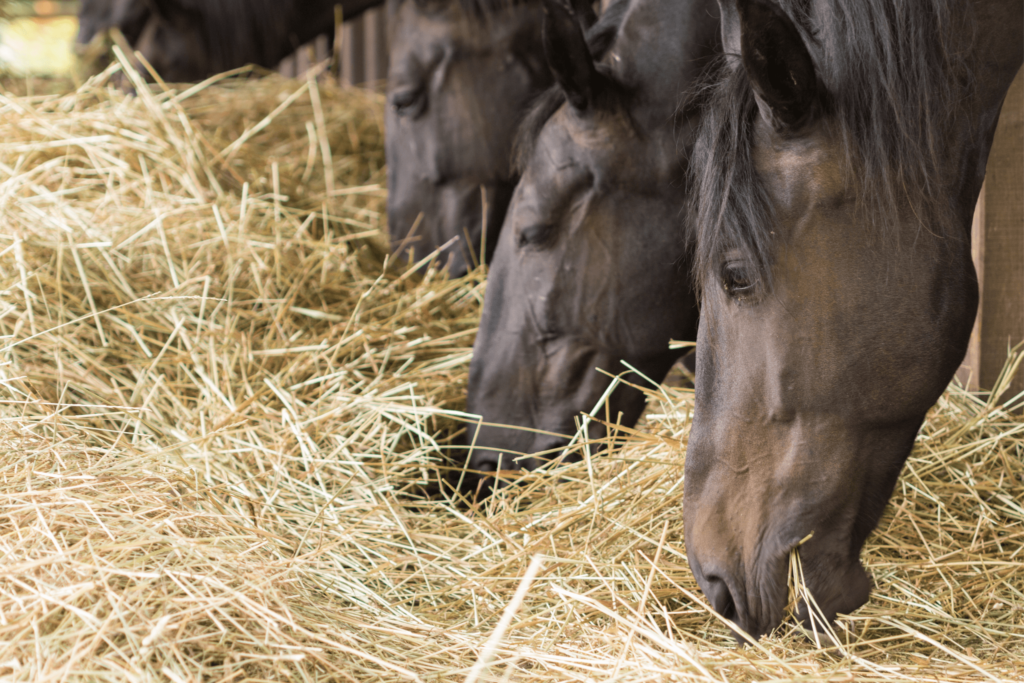
Source: Canva
If you do some quick math and assume you’re getting about 45 pounds of hay per bale, then your average horse will eat a little over 3 bales per week. That’s around 12 bales per month. How much will that cost you? If you can get nice, horse-quality hay for $5 a bale you’ll be paying almost $60 a month, but if you have to pay $19 a bale it’ll run you $228 a month. Yikes.
As you can see, the cost of feeding a horse really depends on where you live.
We can use my mare as an example. She’s a 28-year-old mare that weighs about 1,000 pounds. She has some dental problems due to age, so I feed her some really nice, soft orchardgrass hay. Oh, and we live in North Carolina.
I pay $12 a bale, delivered and stacked because I’m lazy, and they weigh around 45 pounds each. She costs about $5 a day in hay, or $140 a month.
My secret trick is that I have a wonderful, large pasture that supplies more than enough forage for a big chunk of the year. I only need to purchase hay from around November through March. Due to this pasture, I only need to spend $750 a year for her hay, instead of $1,800.
This does not include the cost of pasture maintenance, however. To keep a pasture in excellent condition you need to repair the fence, mow and trim around posts, cross-fence to control grazing zones, have the soil tested, and apply lime and fertilizer as needed.
If you don’t maintain the pasture you have it can quickly become overrun with weeds and the amount of nutrients the horses get will drop considerably. If this happens, you may need to buy hay all year despite having a pasture.
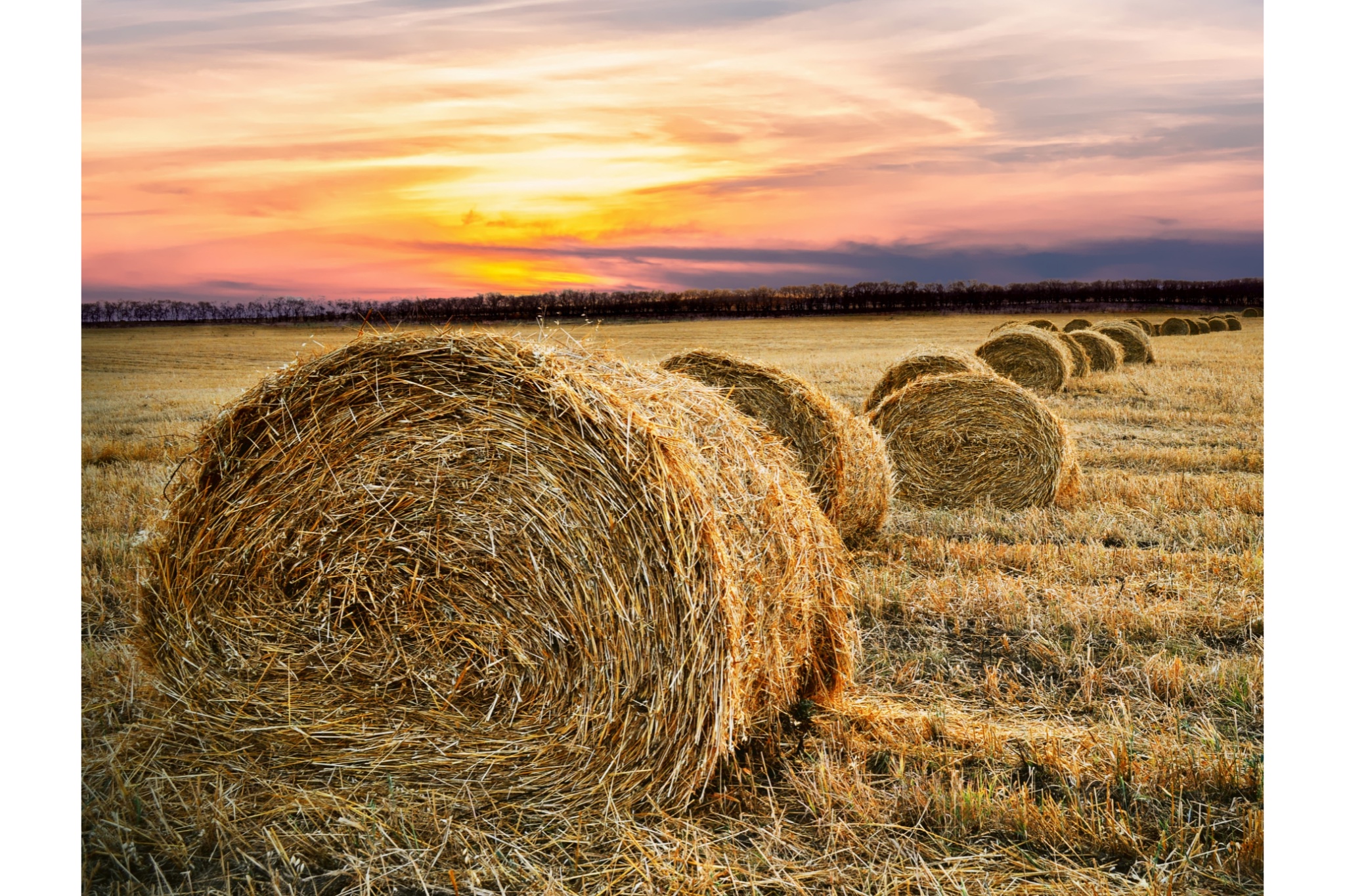
Source: Canva
Keep in mind:
- A horse will need less hay if they have access to pasture for grazing.
- Pelleted feeds also may reduce the amount of hay your horse needs, just remember that your horse needs a lot of fiber throughout the day to keep her tummy happy.
- Some horses have special dietary needs and may require certain types of hay, or even no hay at all. Luckily the magic of modern nutrition is helping horses live longer, healthier lives even despite their medical conditions.
Feed / Grain
Feed or grain is commonly fed to horses to provide extra calories and nutrients. While many horses under light work can get by just fine on hay and/or pasture, some horses really benefit from, or flat-out require, the extra nutrition that comes from a concentrated feed.
Pregnant or nursing mares blow through a lot of calories and may struggle to consume enough to maintain their body condition – particularly during lactation.
A supplemental feed can really help them since it contains a higher calorie density than forage. Growing foals, and horses that are doing more strenuous work, may also require supplemental feed to make sure they’re getting enough calories to burn and nutrients to keep their bodies in tip-top shape.
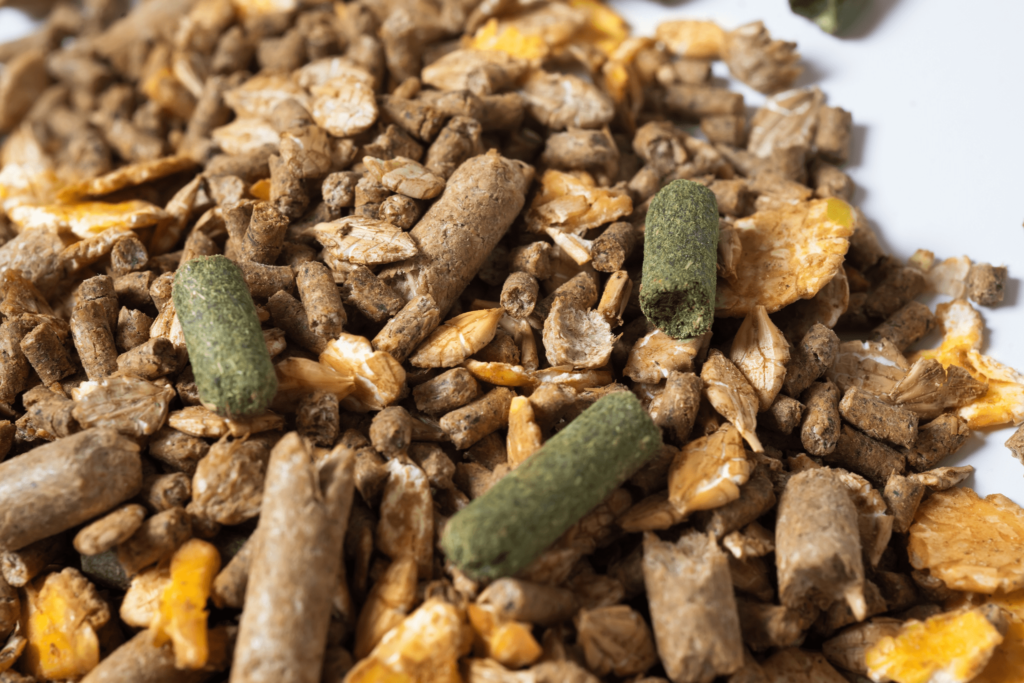
Source: Canva
There are wonderful feed options available for senior horses these days, too. Many manufacturers even make complete diets, which contain all of the forage a horse needs in a convenient pellet shape. Horses with bad teeth now have the option of stay fat and sassy since you can soak these diets and make a delicious, easy-to-eat mash.
While you should avoid overfeeding your horse no matter their age, a complete feed can help keep your senior in good condition.
Another group that may need supplemental feed are the hard keepers. These horses can stand there eating top-quality hay all day and night and still be skinny, so an extra boost is required to keep their body condition up.
Many companies have diets now that are grain-free and high-fat that can prevent your horse from getting hot and spooky, which is excellent news for some frustrated horse owners out there.
The amount of money you spend on feed will ultimately depend on how much extra calories your horse needs.
Some lucky horse owners only need to give a handful a day to convince them to eat their supplements. Of course, other people are maxing out the amount of concentrate a horse can safely consume in order to keep them from looking like a skeleton.
If your horse has plenty of pasture and hay you may opt to feed a balancer. Balancers supply a certain amount of vitamins and minerals and are used to “balance” a forage-based diet, or when you are feeding below the “recommended amount” of feed per day.
Most horses only require a small amount per day – around 1 to 1.5 pounds for the average 1,000-pound horse. If a 50-pound bag of balancer costs you $35 you may only spend $0.70 per day, $4.90 a week, or $19.60 a month. Not bad.
Let’s again take my mare for example. She’s 28 and has missing teeth, so she gets a mash of a complete senior diet. Her feed costs about $25 for a 50 pounds bag, which is a bit more than some of the other brands. The recommended starting amount is 6 pounds per day, which I split into two meals, so she gets about 8 days out of one bag.
Sure, it only costs about $3 a day which is about the price of a small latte. It adds up, though, so that $3 a day is about $21 a week, or $84 a month. Combined with the hay over winter she costs me $224 a month to feed.
Keep in mind:
- Always follow the directions on the feed.
- Any feed changes need to be made slowly to prevent GI upset.
- Not all horses “need” grain, so don’t feel pressured into feeding it if their calorie and nutrient needs are being met with forage, or forage and a balancer.
- When in doubt contact your veterinarian or agricultural extension office for advice.
Supplements
Supplements are all the rage for both humans and animals, and you’ll be hard-pressed to find someone who doesn’t feed their horse a little something extra. There are thousands of different equine supplements on the market for all different reasons. Some are said to boost hoof health, others are calming, some protect the joints, and others improve digestion or help with respiratory issues.
Every inch of your horse’s body, it seems, inside and out, has a supplement manufactured for it!
It can be overwhelming when you first start looking at supplements because there are just so many out there. So many of them do the same thing or are pretty similar, which makes it even tougher. The good news is your horse likely may not need a supplement. If they receive adequate nutrition and are a pretty normal, healthy horse, they likely don’t need anything.
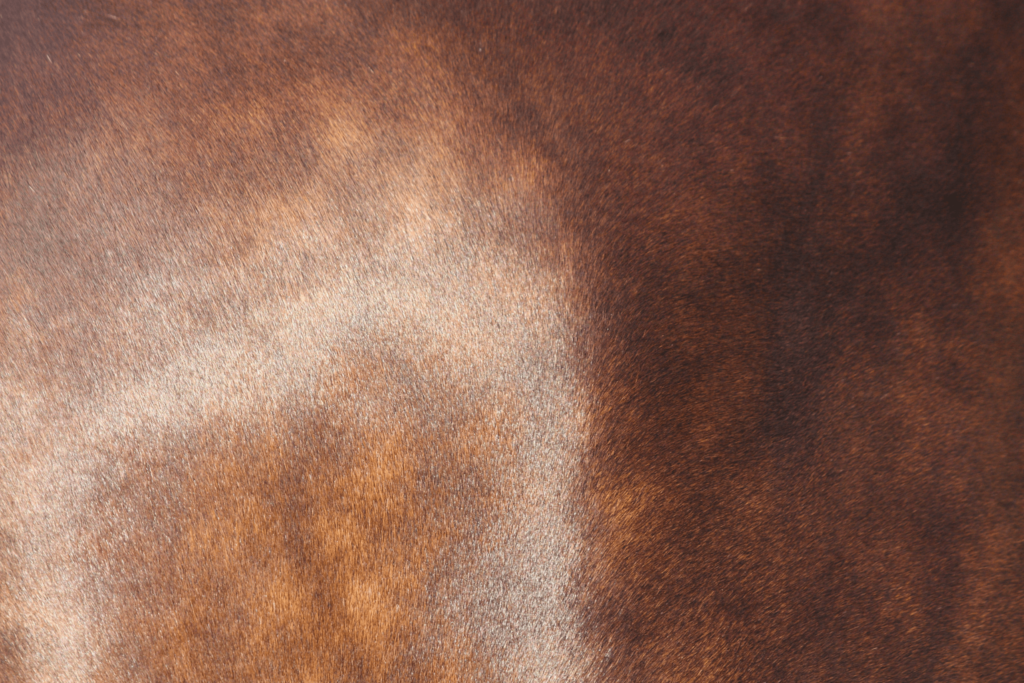
Source: Canva
Regardless, if you want to boost their hoof health, improve their skin and coat, or whatever reason you might have, there are supplements out there for you.
The cost varies pretty wildly so it can be tough to calculate without having a specific need in mind. Some supplements might only cost pennies a day to feed (I’ve seen many that are only $0.40 a day) or they could be ridiculously expensive (like the $5 a day).
Using our example mare again – she gets a really nice senior supplement that supports her skin, coat, hooves, joints, and tummy. I have it on a subscription, which reduces the overall cost, so it runs to about $3.71 a day. That’s $26 a week or $104 a month. Adding it all together now, I’m at $328 a month (during winter) for one horse. She’s worth every penny, though.
Keep in mind:
- Not all supplements are alike and they’re not well-regulated. Do your homework and buy from reputable sources.
- Supplements are little additions to your horse’s diet when they are lacking just a bit. It is a lot more important to make sure they get good quality forage and an appropriate concentrate.
- Always communicate with your vet when it comes to health issues or concerns. While a supplement might be just the thing you need, make sure to rule out any medical issues if there was a sudden change in your horse’s condition or behavior.
Water
Water is often overlooked when it comes to equine nutrition, but it is very important. Horses need a lot of water, particularly if it’s hot out or if they’re eating a lot of dry forage and feed.
A horse just chilling in a comfortable pasture may only need 6 gallons a day, but a mare that is nursing a foal could require 20 gallons.
Your horse’s water should be kept cool and clean to encourage drinking. In winter you may need to heat the water a bit to keep it from freezing and to help your horse to drink more. Since horses eat a lot more dry hay during the cold months, they will need more water.
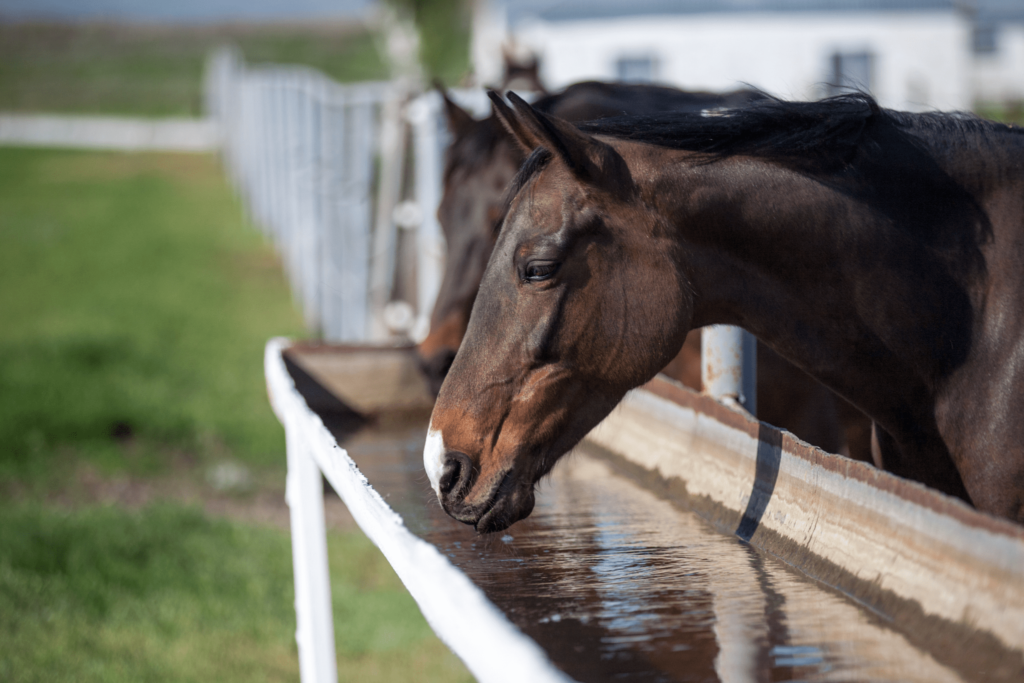
Source: Canva
The cost of water can be difficult to calculate. We use a well, so it only costs me about $0.06 a month to supply water for my horse, not including the cost to maintain the well.
If I lived in the nearby city and had city water, it would cost me about $4 for the meter and $2.17 for one unit (748 gallons). If you break it down, the 280 gallons per 28 days costs about $0.80, not including the meter. Either way, you’ll be paying almost nothing for drinking water for one horse.
Keep in mind:
- If a horse doesn’t drink enough water, they are at risk of impaction colic.
- Keep your water troughs and buckets clean, because old, stagnant water is gross, and your horse knows it. (Would you want to drink it?)
- Supplying salt blocks or electrolytes can encourage a horse to drink more water.
How to Feed a Horse on a Budget
No matter what your situation is, you don’t want to overpay to feed your horse.
If you’re on a budget, the best thing you can do is pasture your horse as much as possible.
A well-maintained pasture can supply a large chunk of your horse’s nutrition, perhaps even all of it. If you board, you might look into pasture-board where they supply a round bale as needed. Boarding in general can help save feed money since large barns can buy hay in bulk.
Of course, this brings us to the idea of buying in bulk. While it requires a lot more money upfront, it can help reduce your overall feed costs. Trying to buy a few bales of hay at a time will cost you more per pound than if you can buy the whole truckload. Many feed stores also offer discounts if you buy a whole pallet of feed.
Supplement companies often offer deals if you buy in bulk or sign up for a subscription. Planning ahead is a great way to stick to a budget, since you can be on the lookout for a deal.

Source: Canva
If you live somewhere that does not have good pasture and hay is hard to find, you may really struggle to keep the costs from getting out of hand, though.
When your feed bill is getting a bit extreme you can try to find a cheaper type of hay and provide a supplement to cover the nutrition change.
Even if the hay is less expensive, it should still be horse-quality and safe. Check it for mold, weeds, and other contaminants, because the vet bills from bad hay can really mess with your budget. And no one wants to make their horse sick.
You should also avoid trying to skimp on hay quantity to save money because horses can develop ulcers and behavioral issues from eating poor-quality forage.
Saving money isn’t worth your horse suffering from colic or starting to chew wood or even crib. You’ll be better off budgeting more for hay and taking money from something else, like the 50 saddle pads a month you expect to buy (ha!).
Frequently Asked Questions
Q: How much should you feed a horse per day?
A horse should consume about 1.5-2% of their body weight in forage per day. If you choose to feed a concentrate, follow the manufacturer’s directions and adjust amounts as needed to maintain a good body condition. Always remember to weigh feed and hay and not base it on volume or “flakes.”
Learn more about what horses eat.
Q: Which hay is best for horses?
Horses need good, horse-quality hay. They are more sensitive than other livestock, so not all hay is safe for them. The hay you choose should be clean, smell nice, and be free of mold, dust, weeds, and other contaminants.
Most horse hay is made up of grass, like orchard or timothy, but you can also feed legume hay, like alfalfa or clover, if your horse requires it. You may also use coastal, Kentucky bluegrass, or fescue depending on where you live.
Q: What hay should horses not eat?
Although most horses will eat almost any type of hay, there are some that are dangerous to a horse’s health. Switchgrass can cause photosensitivity, liver disease, and mouth ulcers, while sorghum grasses can cause abortion in mares, and bladder cystitis. So-called “cow grass” is palatable and relatively safe, but doesn’t contain the energy or protein levels a horse requires.
Learn more about different types of hay.
Q: What supplements does my horse need?
Your horse may or may not need supplements. A high-quality, well-balanced diet is perfectly adequate for most horses, but if they are lacking in certain minerals you may need to supplement.
You may also choose to find a supplement to help your horse’s mood or stress response, support joint health due to their activity, or support their skin and immune response if they’re sensitive to bug bites.
Learn more about what horses eat.
Q: Why feed bran mash to horses?
Bran mash is most commonly used during cold weather to increase water intake or in general to help prevent colic. Other owners use it as an occasional treat or as a way to feed a sand clear product. Some believe it encourages regular bowel movements.
You can add tasty ingredients like molasses, apple slices, or carrot chunks to make the mash more appealing.
Be careful not to feed bran mash too often, as it has a high phosphorus-to-calcium ratio (10p:1c) which can create an imbalance in your horse’s diet. Once a week makes for the perfect treat.
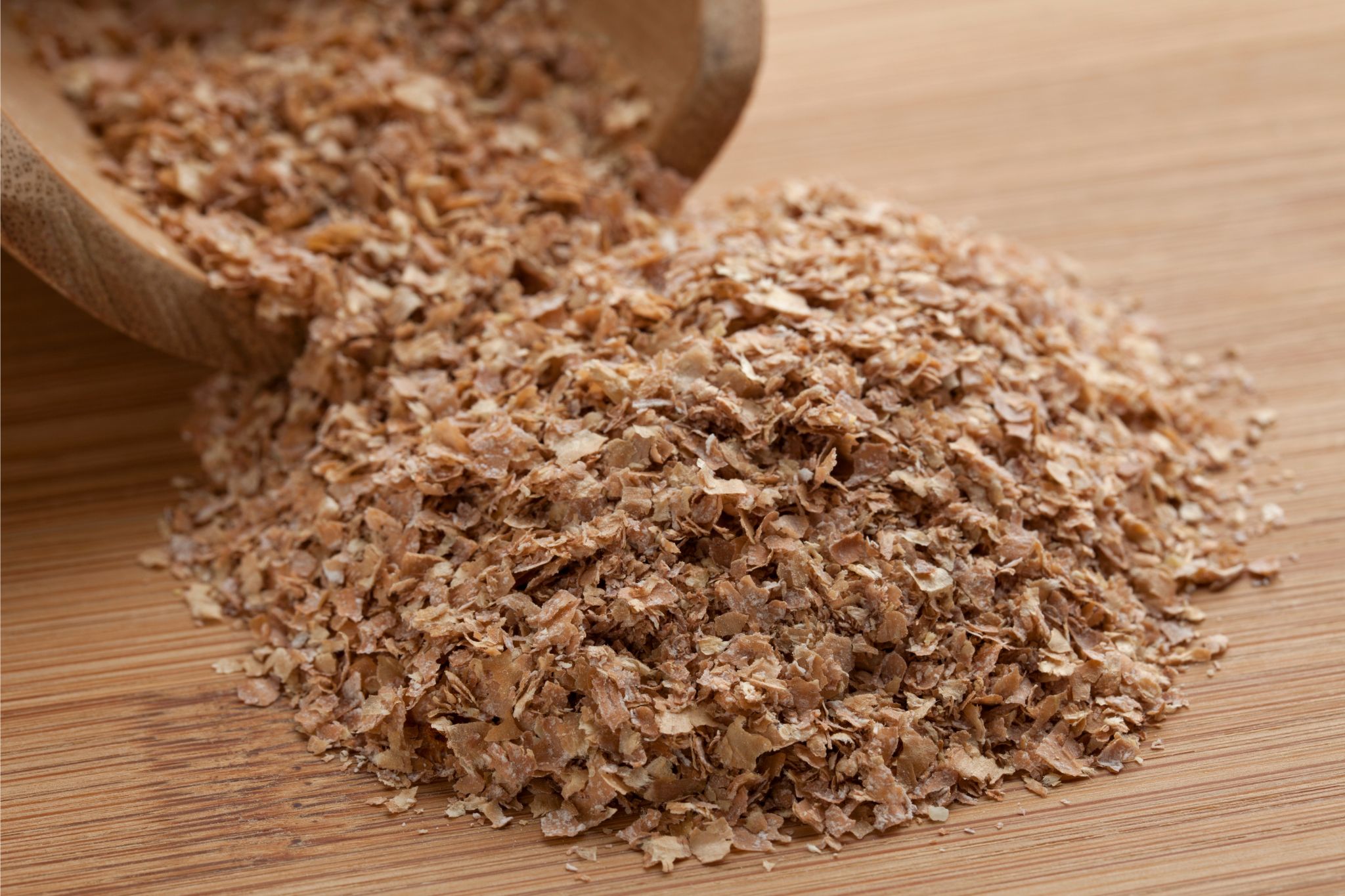
Source: Canva
Q: Bran mash vs beet pulp?
Bran mash is more suitable as an occasional treat than as a regular part of your horse’s diet. It doesn’t add a significant amount of nutrients, and the imbalance of calcium to phosphorus can be damaging with prolonged use.
Beet pulp can be a regular (daily) part of your horse’s diet. If you choose molasses-free, it’s low in sugar, high in digestible fiber, and helps support healthy gut flora.
If you’re running low on hay, you can supplement with beet pulp (but don’t replace hay completely). Substitute at a 1:1 ratio (1lb dry beet pulp for every 1lb of hay) up to three pounds a day.
Parting Thoughts
Horses can be either cheap or expensive to feed, depending on your location and your horse’s individual needs. If you are just casually considering buying a horse and wondering what you can expect to pay to feed it, this can be quite frustrating.
Feed is one of the most important things to consider when deciding on whether or not you can afford a horse, though, because good nutrition is the foundation for health and happiness.
If you want to focus on the cost to feed a horse, you should talk to other horse owners around you. Find out how they get hay, what it costs, how they maintain their pastures, and where they purchase their feed and supplements. If you’re planning on boarding, call around to the different facilities to get an idea of what you can expect to pay.
Also, consider that the horse you buy may have specific nutritional needs or may eventually require a change in feeding over time. It is wise to budget for emergencies or set your initial budget low to compensate for these unforeseen expenses. Owning a horse is wonderful, but make sure you can afford it without spending all your time working, instead of riding.
P.S. Enjoy this article? Trot on over to:
- Horse Hay FAQs: List of Types of Hay, What Hay is Best, etc.
- Winter Hay 101: How Much to Feed Your Horse (And Why)
- Beginner’s Guide to Horse Hay Nets & Bags
- Food or Foe: What Do Horses Eat (And Why)
- Fact of Fiction: Do Horses Eat Meat?
- Estimate Your Average Horse Cost (State by State)
- 3 Types of Horse Feed Every Owner Should Understand
- Solving the Senior Horse Feed Equation (Supplements, Hay, Grain, etc.)
- Best Supplements for OTTBs Who Need Extra Support

